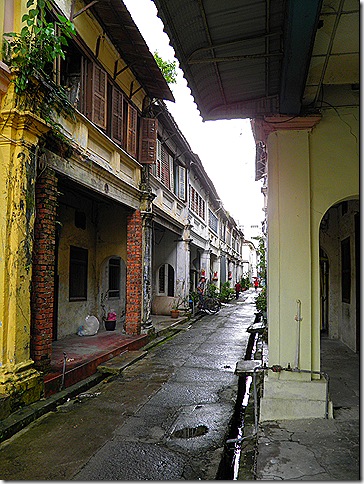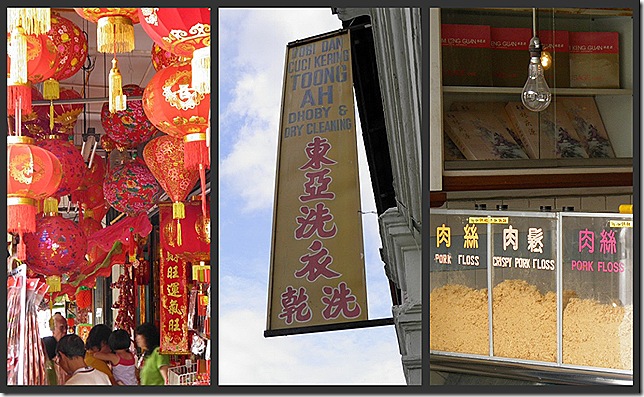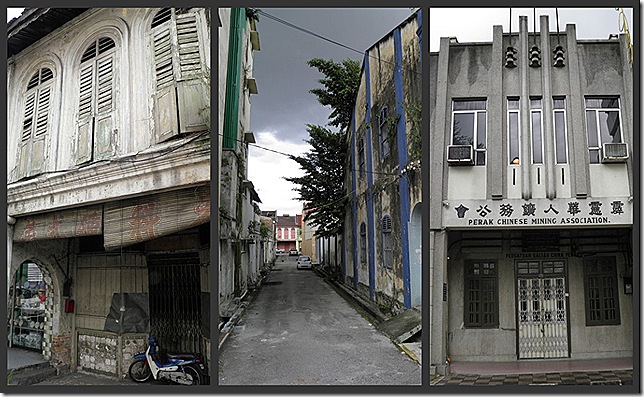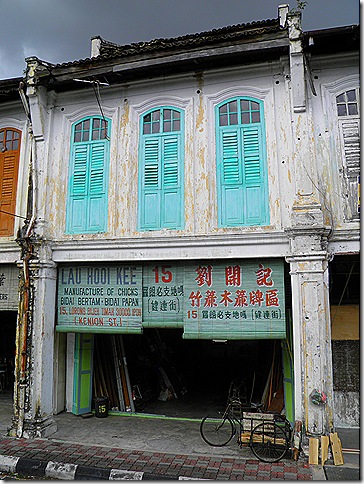Ipoh is famous for its food. Indeed the main attraction for any Malaysian to visit Ipoh would probably be to sample their specialty dishes. Only crazy people like me would go to Ipoh to stroll around taking photos of decaying buildings.
Ipoh’s famous such dishes include Sar Hor Fun (noodles in soup with chicken and prawns), Hor Hee (noodles with fish cakes and fish balls) and Popiah (pancake stuffed with minced prawns, bean sprouts and turnip).
Since my plan to have lunch at the F.M.S. Bar & Restaurant had been thwarted I had to find alternatives.
The Soon Fatt Restaurant seemed like a good place to add a few kilos. In the afternoon, after a brief downpour, I felt I had to sample the famous Ipoh White Coffee. The beans are roasted by a special method and the brew is sieved, mixed with both condensed and evaporated milk and served slightly frothy. It’s delicious although a little too sweet for my taste.
Suitably refreshed I continued on my walking tour of old Ipoh.
When Ipoh was experiencing its ‘Tin Rush’ it became a bit of a Wild East town, full of opium dens, illegal gambling joints, brothels and so on. Wealthy Chinese tycoons would acquire mistresses (concubines) and install them in streets such as this one, known as Second Concubine Lane. Presumably it was not as run down as it is today.
Ethnic Chinese make up about 70% of Ipoh’s population and their influence is strongly felt.
Where else in the world would a laundry advertise its services in Malay, English and Chinese and use the Indian word ‘dhoby’?
There are some historic mosques in Ipoh too, notably the Padang Mosque built in 1908, financed by Shaik Adam, a wealthy Tamil businessman, and the Dato’ Panglima Kinta Mosque built in 1898.
The Little India District has a colourful selection of curry houses, jewellers, textile shops and so on.
The ‘shophouse’ is very characteristic of Malaysia. The earlier examples have decorative architectural features and for the foreign tourist they are just as much an attraction on the Heritage Walk as the grander, British colonial buildings. Singapore was rapidly bulldozing their old shophouses when they realized that they were a valuable tourism asset and Singapore has since done an excellent job in preserving and restoring what they have left. Penang and Malacca, now UNESCO world heritage sites, have also been busy renovating their old streets. Kuala Lumpur has a number of old shophouses but they tend to be scattered around. Ipoh’s are found in a more compact area but many are in a woeful state and much needs to be done if this heritage is going to be preserved.
It looks like efforts have been made to preserve the facade of this shophouse below but the advertising hoarding on the money changer next door rather spoils the appearance of the block.
Another example of where tighter planning controls might be in order is this block in Jalan Sultan Iskandar (formerly Hugh Low Street). The left hand shop has retained its original wooden shutters whereas the right hand shop has replaced their shutters with aluminium windows which spoil the overall effect. As for the middle shop – what a monstrosity!
Incidentally, I had come across the name Hugh Low before in my travels in Malaysia when climbing Mount Kinabalu. Sir Hugh Low was a colonial administrator and the first recorded climber of Mt. Kinabalu in 1851. The highest point on the summit is called Low’s Peak.
It seems the key to ensuring the survival of heritage shophouses is ensuring that they remain occupied and that the owners make sufficient profits to pay for the upkeep of the building or, if not, to receive some government support or subsidies. Preserving traditional crafts and occupations, such as this manufacturer of chicks, is also important in attracting tourists. Chicks, in case you are not familiar with the term, are those rolling bamboo blinds that are an essential accessory to the classic shophouse. Extremely practical, they keep out the rain, provide shade during the heat of the day, and serve as advertising billboards.
Arriving in Ipoh with low expectations, I was quite impressed with the place and feel its heritage tourism potential is underrated. Possibly what Ipoh lacks is an anchor attraction to draw in the visitors. If I were a highly paid consultant to Ipoh’s city planners what would I recommend?
- Give the Majestic Hotel and Railway Station the Raffles treatment, i.e. upgrade the hotel to top-notch 5 star status. This might be tricky with a busy railway station downstairs but I am sure it could be achieved (if necessary by building a modern railway station a few hundred meters down the track and leaving the old one to become part of the hotel).
- Vacate the neighbouring Town Hall and High Court buildings and make them part of the same hotel complex. The Town Hall would make excellent ballroom/conference rooms for the hotel or an up market retail/dining mall. The High Court could be converted to a casino, luxury spa or extra hotel rooms.
- Hold annual events to put Ipoh on the international map. For example, since Ipoh is already famous for its food, it could hold a month long Malaysian street food festival. Ipoh White Coffee and Cameron Highlands teas could form part of the marketing mix.
- Ipoh is said to produce some of the best pomelos. Promote these and other Malaysian fruits in an annual fruit festival. Thailand has done a great job in promoting its tropical fruits as a tourist attraction. Malaysia could surely do as well.
- Apply for UNESCO world heritage status for Ipoh Old Town. It might not be successful but the the application process itself would help identify what needs doing.
No charge for the consultancy!










